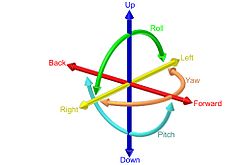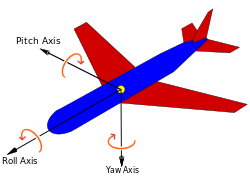Pitch, yaw, and roll
Pitch, yaw and roll are the three dimensions of movement when an object moves through a medium.


The terms may be used to describe an aeroplane's movements through the air. They are also applied to watercraft moving through water, and spacecraft moving through space.
There are in fact six degrees of freedom of a rigid body moving in three-dimensional space.[1]
As the movement along each of the three axes is independent of each other and independent of the rotation about any of these axes, the motion has six degrees of freedom (see diagram).
- pitch
- nose up or tail up.
- yaw
- nose moves from side to side
- roll
- a circular (clockwise or anticlockwise) movement of the body as it moves forward
The surfaces of a plane and the fins of a fish have a similar function. They serve to adjust the object's attitude as it moves through the fluid.[2] Submarines face the same dynamic control problems as fish do.
The subject is often taught under degrees of freedom (mechanics). This is the number of independent motions that are allowed to the body.
References
change